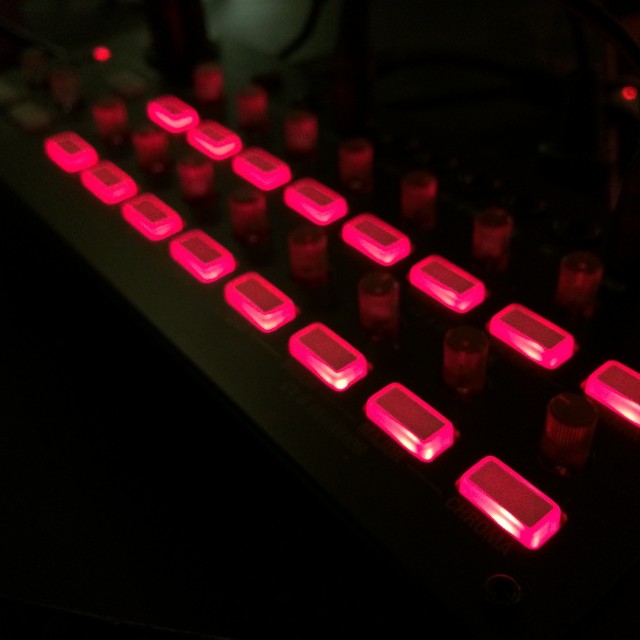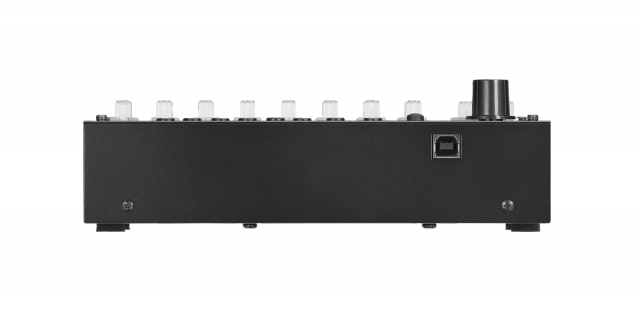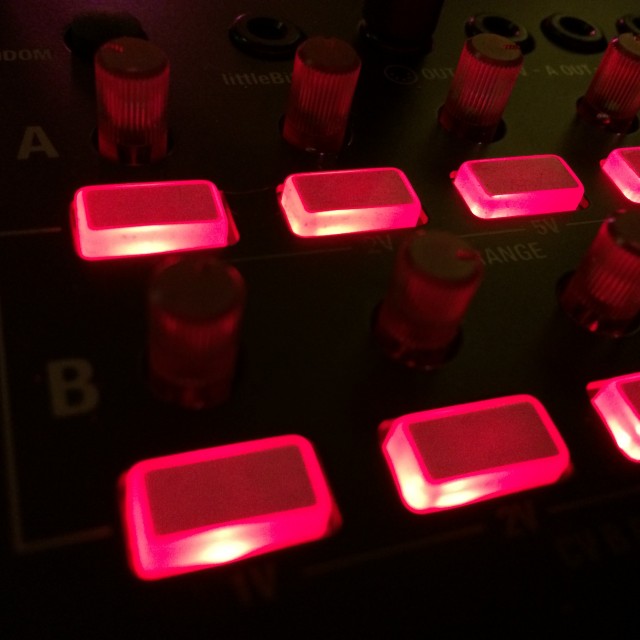It costs just a hundred bucks. It’s tiny, in a metal case with ultra-compact knobs and light-up buttons for hands-on control. And with MIDI, USB, CV, and even dedicated littleBits ins and outs, there’s a reason I described the announcement of KORG’s new SQ-1 sequencer as a sequencer that does everything.
But doing everything in such a little box is a tall order. And the SQ-1 packs in so much, it’s not obvious what its capabilities can be. One one hand, there are some powerful features that you might completely miss (like MIDI-to-CV capabilities). On the other, it has some limitations you should know about, as well. In trying to be all things to all gear in the smallest package possible, it has to make some sacrifices – so it’s better at some jobs than others.
I’ve gotten my hands on one and begun to use it (thanks to a studio neighbor who brought one back from Japan). And I’ve been in touch with KORG’s engineers in Japan to clarify its capabilities. So, let’s take a detailed look.
Overview
The SQ-1 is available both on its own and in a bundle with the new MS-20 module – though I’m guessing it’s mainly of interest as a compact, affordable standalone sequencer. Its name is a nod to the vintage SQ-10, but it’s only loosely based on that.
What you get:
A small, metal box with little plastic knobs (as found on the volca series), red light-up buttons
93 x 84 x 63 mm/7.60″ x 3.31″ × 2.48″
641 g/1.41 lbs.
Runs on AA batteries or USB power (USB power adapter will work, that is, if you’ve got one)
Connections:
CV out: pitch (Linear, Minor, Major, Chromatic)
CV out: voltage (1V, 2V, 5V (Oct) 8V (Hz/V))
Gate out (positive or negative polarity – that is, rise and fall)
littleBits OUT jack
MIDI out (via an included Mini plug – DIN cable for MIDI)
USB jack (for USB MIDI)
Sync in and out jacks (just like on the volca, monoTribe, etc.)
How it operates:
Sequencer modes: alternate, order, parallel turn, parallel order, CV/DUTY, CV/SLIDE, CV/DUTY RANDOM, random
Steps can be gate on/off, active step, slide, or step jump
Resolution of step can be quarter notes, eighth notes, sixteenth notes
MIDI Implementation
Spoilers! Let’s go ahead and look at what MIDI the SQ-1 can receive and transmit, because – well, it’s otherwise kind of a guessing game. (CV is more straightforward.)
As per usual, KORG have uploaded the MIDI Implementation Chart, in English, on the Japanese site … but you won’t find it on the international sites.
You will find it here:
http://www.korg-datastorage.jp/Manual/SQ1_MIDIChart_E.pdf
MIDI Behavior – and Some Limitations
It’s a little box with very few controls. So, prepare yourself: a lot of what you might like to do with the SQ-1, you can’t.
On the independently-moderated Korg Forums (hosted by KORG USA but not operated by them), you’ll find a helpful post from a tester on what is and isn’t possible with MIDI:
Korg SQ-1 MIDI-behaviour [“chris-korg” in Austria]
I went through and verified this with my own testing, and Korg engineering in Japan. So, I’ll repeat a bit what was said before, but with some commentary and doubly-sure what I’m saying is correct.
1. There’s no hardware MIDI input. MIDI input and output is available via USB, but there’s only the single MIDI output minijack (which you can attach to gear with MIDI DIN input ports via the included cable). So input can only come from a computer. That means, in effect, that the SQ-1 has to be a clock source when you’re using it standalone.
2. You can receive MIDI clock over USB, but it’s limited. If the SQ-1 has an external MIDI clock source, it will slave to that source. The only way to do that is over USB (since there’s no other input). However, and this is where things get a bit weird, you can’t then transmit that same clock signal to the SQ-1’s MIDI out.
At least if you make the SQ-1 a clock source – or use its analog sync input – it’s more useful, as it then transmits MIDI clock to its output normally.
3. You can chain SQ-1s. If you chain SQ-1s via the SYNC in and out ports, you can get two or more running in sync. But that SYNC connection in general is limited: it uses clock, but not start/stop.
4. There’s no “linear” mode in scale selection when using MIDI. MIDI can adjust scales, though you’re limited to chromatic, major, and minor. Here, analog gear has an advantage: it’s only via the CV output that Linear behaves as described. Now, KORG could have gotten fancy and implemented linear operation with pitch bend messages, but they described that was overly complicated – and transmitted too much data.
The same is true of “slide” functions – they work via CV, but not MIDI (by design). For slide between notes on outboard MIDI gear, you just need gear with a portamento/glide function.
5. Scales are limited to C Major and C minor; you can’t change root or transpose. Chris correctly points out that this is fairly limiting. You can’t change the root note. The KORG engineer who designed the SQ-1’s functionality here told us somewhat apologetically that he had only two buttons for selection, though, so he didn’t have much choice. This sounds like a deal killer, maybe, but it isn’t – provided your outboard gear has a transposition function. If it does, you can transpose on the synth rather than the SQ-1. And if you want more scales, you may want to consider a more advanced sequencer – or software.
6. Pitch range is the same on CV and MIDI. Pitch begins with C and covers a range of 1, 2, 3, or 5 octaves.
7. You only get pitch and gate length – nothing else / no CC’s. You can’t transmit Control Change messages on the SQ-1. The SQ-1 recognizes just one Control Change message – CC 120, for all notes off. (Yeah, you want that one!)
8. You can’t define the MIDI channel of row B. It’s always just one channel higher than the main channel.
Sequence modes
The above writer Chris helped explain sequence modes that the SQ-1 manual does not.
Looking at the modes clockwise from left on the SEQUENCER MODE selector knob, where the top row of steps is row A and the bottom row B:
Modes 1 and 2 (alternating A/B, A->B): 16-step sequencer (by linking A and B). Step knobs change pitch. Gate length (duty cycle) is controlled by the duty knob.
Modes 3 and 4 (parallel reversing direction, parallel): 2 x 8-step sequencer. The top row step knobs work as pitch, the second-row step knobs work as pitch on a MIDI channel one channel number higher. Gate length is controlled by the duty knob.
Modes 5 and 7 (CV DUTY and CV DUTY RANDOM): 1 x 8-step sequencer. The top row is pitch, the bottom row is gate length. The duty knob is inactive.
Mode 6 (CV SLIDE): 1 x 8-step sequencer. The top row is pitch. The bottom row is unassigned (confirmed by KORG, wasn’t in the post above). The buttons below those unassigned knobs function for activating slide – just as the buttons do on the top row. So, the knobs are unassigned; the buttons are assigned but redundant.
Mode 8 (RANDOM): 16-step sequencer. Knobs control pitch. Duty controls gate length.
How step resolution behaves:
The above tester also looked at how the sequencer step resolution behaves when you change the global parameter settings.
A/B, A->B, parallel reversing direction (1-3). The SQ-1 responds to external clock. But its sync out will change as you change modes – 4x, 2x, 1x – so it acts as a clock divider.
Parallel, CV DUTY, CV DUTY RANDOM, CV DUTY RANDOM, CV SLIDE (4-8). In these modes, the SQ-1 clocks at half tempo to an external source. Here again, sync out from the SQ-1 changes at 4x, 2x, 1x.
In modes 7 or 8, there’s another twist. As KORG tells us: “When you save the Global parameter, SEQUENCER MODE should be set to Mode 7 or 8 If you don’t want to change the STEP resolution.” (Chris had assumed modes 7 or 8 didn’t work.)
What’s it Like in Use?
I quickly got the SQ-1 running with KORG’s volca sample – and our own MeeBlip anode hardware synth. The result is an impossibly small, all-in-one, live hardware rig. The trick is to send MIDI to the MeeBlip and send sync signal to the volca sample. You can then use the volca’s perfectly capable internal sequencer.
The SQ-1’s selection as a pack-in with the MS-20 makes a lot of sense. As a little monophonic analog sequencer, it’s just about perfect.
I think the trick is, at first glance it also seems like a do-everything MIDI sequencer. It’s just too limited to cover all your sequencing needs. I’m a bit disappointed with Korg for some missed opportunities to make it more flexible.
1. MIDI in: If it only had MIDI DIN input, it would be easy to stick this at the end of a chain with other gear.
2. Send and receive clock: Two, if it could transmit and receive MIDI clock at the same time, obviously, it’d be hugely easier to put in a bigger rig.
3. Use CCs to add depth: while I understand that they ran out of room on the front panel for features and didn’t want to overcomplicate things, I wish it could use MIDI CCs to receive additional controls – like transpose, for instance.
In the end, cute as this thing is, you have to decide whether you really need a box with tiny knobs to sequence in C – at least if MIDI is your main (or only) target).
The other frustration for me is, the moment you turn the SEQUENCE MODE dial, the sequence retriggers instantly. It’d be great to change sequence order as you play to make variations, but since there’s no why to turn the dial precisely on a beat. Some step sequencers are able to operate this way: they simply quantize the next step to the active beat grid, so that when you make a global parameter change, it doesn’t throw off all of your timing.
With that big knob and the different sequence directions being one of the most compelling features of the sequencer, this winds up being a significant deal in coming up with creative sequence applications.
As with Arturia’s BeatStep (see my previous review), which did eventually spawn the BeatStep Pro, I guess using the SQ-1 I sort of immediately want, well, an SQ-1 Pro. (SQ-10 mini?) Of course, the BeatStep Pro is still coming, so it may turn out that that’s exactly what we get.
In the meantime, for a hundred bucks the SQ-1 still makes a whole mess of sense in many instances. If you’ve got some analog gear around to control and want a little gadget to make some sequences, it’s an obvious purchase. And because I like twisting dials, it’s still fun with MIDI – I’m just not sure I’d get it if MIDI were all I was using.
This does mean that you might tuck away that hundred bucks toward the purchase of advanced sequenced hardware – or software. Given that some of the SQ-1’s MIDI functionality requires it to be tethered via USB anyway, you should consider tools like the amazing modular Numerology Pro – or just mapping an onboard sequencer to a controller. It’s also why I’m looking forward to ModStep – the iPad mini is equally compact, too, and then you have layers, MIDI CCs, any scale you want, none of these quantization problems, and so on.
Don’t get me wrong: I like the SQ-1. Once you’re aware of what it can and can’t do, it may well find a nice place in your rig for analog and digital gear. But you can’t blame us for dreaming of something that, in hardware, does a little more, without turning to enormous or expensive hardware sequencers. Stay tuned – we’ll see if that dream gets fulfilled.
In the meantime, I think the SQ-1 is a winner if you want something extra that’s portable to make sequences, if you have some analog gear to drive in combination with digital, or both.
SQ-1 in videos
Let’s watch some of the best demonstrations of the SQ-1 in use – partly because, at the end of the day, it’s what you do with this hardware that matters.
It’s great to see the new SQ-1 unite with vintage MS-20 and MS-10 synths. And it’s clearly well-matched to monosynths, generally.
For more vintage loveliness, there’s my favorite retro KORG, the Mono/Poly, plus a Prophecy:
It’s nice to see paraphonic use, with transposing, as here. And again, your best bet is to transpose on the outboard gear since you can’t on the SQ-1:
The French-language La Boite Noire du Musicien has shot some gorgeous films of the SQ-1 as part of the MS-20 kit. They’re nice to just watch:
But my favorite SQ-1 jam so far, musically speaking, is this transporting journey, which adds not only the volca sample, as I did, but an Elektron Analog Four and the Czech-built microGranny granular sampler. The microGranny is really a perfect addition to these rigs. Don’t forget to support independent hardware.
And finally, for a novelty, here’s a project that uses a physical metronome as a clock source. No, really. The trick is to apply a mic to the metronome. The actual sound of that metronome drives the clock – it’s the magic of analog. Nice one, karenevil, whoever you are:
Big thanks to Ikuo Koyama for the use of his SQ-1. If you read Japanese (or you’re satisfied looking at pictures and videos), his site is excellent:
http://1ikkai.com


